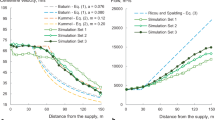Abstract
When the subway train operates at a speed higher than 100 km/h, the corresponding aerodynamic issue becomes severe. To meet the future requirement for the speedup of subway trains, a research on the critical diameters of the subway tunnel for trains operating at 120 and 140 km/h has been performed based on passengers’ aural discomfort caused by rail tunnel pressure variation. A three-dimensional computational fluid dynamic approach has been adopted for analysis. Meanwhile, trains with different airtight indices are considered and the pressure variations inside and outside the trains are both under investigation. Based on the corresponding criteria for different airtight indices, critical tunnel diameters for trains running at different speeds have been determined. This study would aid in the tunnel section design for future high-speed subway trains.
Similar content being viewed by others
References
Howe M S. On the infrasound generated when a train enters a tunnel. J Fluid Struct, 2003, 17: 629–642
Zhao Y, Gao B, Zhang Z J. Three-dimensional numerical simulation of tunnel pressure waves (in Chinese). Subgrade Eng, 2007, 4: 12–14
Raghunathan R S, Kim H D, Setoguchi T. Aerodynamics of high-speed railway train. Prog Aerosp Sci, 2002, 38: 469–514
Wan X Y, Wu J. In-situ test and study on the aerodynamic effect of the rolling stock passing through tunnels with a speed of 200 km/h (in Chinese). Mod Tunn Technol, 2006, 43: 43–48
Baker C J, Dalley S, Johnson J, et al. The slipstream and wake of a high-speed train. P I Mech Eng F-J Rai, 2001, 215: 83–99
Zhao W C, Gao B, Wang Y X, et al. Analysis of the pressure wave variation generated by a high-speed train passing through a tunnel (in Chinese). Mod Tunn Technol, 2004, 41: 16–19
Thermo Tun-Software[EB/OL]. http://www.thermotun.com/index.htm.
Wang Y W, Yang G W, Huang C G. Influence of tunnel length on the pressure wave generated by high-speed trains passing each other. Sci China Tech Sci, 2012, 55: 255–263
Yonn T S, Lee S, wang J H, et al. Prediction and validation on the sonic boom by a high-speed train entering a tunnel. J Sound Vibr, 2001, 247: 195–211
Shin C H, Park W G. Numerical study of flow characteristics of the high speed train entering into a tunnel. Mech Res Commun, 2003, 30: 287–296
Yakhot V, Orszag S A. Renormalization group analysis of turbulence: I. Basic theory. J Sci Comput, 1986, 1: 1–51
Fluent Inc. FLUENT 6.3 User’s Guide [EB/OL]. http://www.fluent.com
Mei Y G, Zhao Z H, Xu J L. High-speed Railway Tunnel Aerodynamics (in Chinese). Beijing: Science Press, 2009. 206–208
Pierre P, Arturo B, Paolo M. Nature of pressure waves induced by a high-speed train travelling through a tunnel. J Wind Eng Ind Aerodyn, 2007, 95: 781–808
Author information
Authors and Affiliations
Corresponding author
Rights and permissions
About this article
Cite this article
Sun, Z., Yang, G. & Zhu, L. Study on the critical diameter of the subway tunnel based on the pressure variation. Sci. China Technol. Sci. 57, 2037–2043 (2014). https://doi.org/10.1007/s11431-014-5664-4
Received:
Accepted:
Published:
Issue Date:
DOI: https://doi.org/10.1007/s11431-014-5664-4



